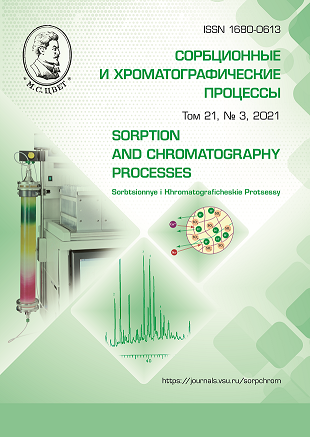Sorption materials for the solid-phase extraction of viscous additives based on polyalkyl methacrylate from lubricants
Abstract
The study was devoted to the investigation of the sorption materials for the solid-phase extraction of viscous additives based on polyalkyl methacrylate from a lubricant and chromatographic determination of the selected additives. The objects of study were individual commercial functional additives based on polyalkyl methacrylate “Maksoil V”, polymethyl methacrylate “D” (PMAD). Concentrating cartridges based on unmodified silica gel "Diapak Silica gel" and hydroxylated silica gel (grain size 5-50 microns) were used as sorption materials. The concentration of functional additives was determined by gel permeation chromatography (GPC). GC-MS identification of polymer additives in eluates was performed using the NIST 07 mass spectra library. For each sorbent, dynamic sorption curves were plotted, sorption characteristics were calculated in relation to the investigated viscous additives (“breakthrough volume”, equilibrium volume, retention volume, etc.). "Breakthrough volumes" using both sorbents were determined for the investigated additives in solvents with different polarities. For the “Diapak Silica gel” sorbent, the “breakthrough volumes” for the “Maxoil B” and PMAD additives were: in a hexane:trichloromethane mixture (7:3 by volume) 0.3 and 0.5 cm3 and in hexane 0.6 and 0.8 cm3, respectively. When the solid-phase extraction of commercial viscosity additives "Maxoil B" and PMAD with hydroxylated silica gel was carried out, the "breakthrough volumes" were: in a mixture of hexane: trichloromethane (7:3 by volume) 1.95 and 1.50 cm3 and in hexane 3.40 and 3.01 cm3, respectively. The degree of extraction of commercial viscous additives "Maxoil B" and PMAD by hydroxylated silica gel with the optimal volume of eluent (acetone) of 1.5 cm3 was 45 and 103 %, and using a less polar eluent - a mixture of hexane:trichloromethane (7:3 by volume) with an eluent volume of 2.5 cm3 was 35 and 86%, respectively. The low degree of extraction of the "Maxoil B" additive is associated with its high molecular weight and, as a consequence, irreversible sorption on a sorbent based on unmodified silica gel. For a more complete extraction of these types of substances it is probably necessary to use modified sorbents.
The combination of sorption of viscous additives based on polyalkyl methacrylate from the base of lubricants from a hexane solution and desorption of analytes with acetone showed a higher efficiency of hydroxylated silica gel in relation to the studied analytes.
Downloads
References
Pranab G., Moumita D. Journal of Petroleum Science and Engineering, 2014, Vоl. 119, pp. 79-84.
doi: 10.1080/10916460701700864
Bapat A.P., Erck R., Seymour B.T., Zhao B. et al., European Polymer Journal, 2018, Vol.108, pp. 38-47.
doi: 10.1016/j.eurpolymj.2018.08.026
Kazantsev O.A., Samodurova S.I., Kamorin D.M., Sivokhin A.P. et al., Petroleum chemistry, 2014, Vol. 54, No 6, pp. 473-476. doi:10.1134/S0965544114060073
Pranav Dev Srivyasa, Charoob M.S. Materials Today: Proceedings, 2019, Vol. 18, part 7, pp. 4773-4781. doi.org/10.1016/j.matpr.2019.07.465
Kuliev A.M. Khimiya i tekhnologiya prisadok k maslam i toplivam. 2-e izd pererab. L., Khimiya, 1985, 312 p.
Akhmedov R.L., Kravtsova S.S., Dychko, K.A., Ramus' I.V., Analytics and control, 2019, Vol. 23, No. 4, pp. 532-538. doi: 10.15826/analitika.2019.23.4.001
Privalenko A.N., Krasnaya L.V., Cher-nysheva A.V., Zueva V.D. et al., Neftekhimi-ya i neftepererabotka, 2017, No 7, pp. 23-26.
Proskurina N.A., Il'in M.M., Davankov V.A., Sychev K.S. et al., Russian Journal of Physical Chemistry A, 2007, Vol. 81, No 3, pp. 424-427.
Temerdashev Z.A., Ivanova Yu.A., Kolychev I.A., Averina E.S. et al., J. of Ana-lytical Chemistry, 2019, Vol. 74, No 12, pp. 1202-1208. doi: 10.1134/S0044450219120132
Ivanova Yu.A., Temerdashev Z.A., Kolychev I.A., Kiseleva N.V., Analytics and control, 2021, Vol. 25, No 1, pp. 53-62. doi: 10.15826/analitika.2021.25.1.003
Zaitsev S.V., Kishnevskii V.A., Shul-yak I.D., Vostochno-evropeiskii zhurnal peredovykh tekhnologii, 2015, Vol. 2, No 6, pp. 21-28. doi: 10.15587/1729-4061.2015.40896
Xiang Y., Qian X., Hua M., Cheng B. et al., Analytical Letters. Electrochemistry, 2016, Vol. 49, No 10, pp. 1526-1536. doi.org/10.1080/00032719.2015.1118484
Rudakov O.B, Fan Vin' Tkhin', Sorbtsionnye i khromatograficheskie protsessy, 2008, Vol. 8, No 1, pp. 141-146.
Bielicka-Daszkiewicz К., Talanta, 2009, Vol. 80, рp. 614-621. doi: 10.1016/j.talanta.2009.07.037
Chukin G.D. Khimiya poverkhnosti i stroenie dispersnogo kremnezema. M., Pala-din Printing House, Printa LLC, 2008, 172 p.
Rudnick R. Synthetics, Mineral Oils, and Bio-Based Lubricants. Chemistry and Technology. Taylor and Francis group, 2020, 1194 p.
Tagirov T.K. Metodika opredeleniya prisadok v smazochnykh materialakh metodom tonkosloinoi khromatografii. M., Ros. Feder. forensic center expertise, 2007, 27 p.







